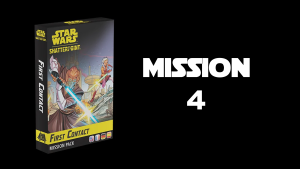Welcome back to our series of articles discussing Star Wars Unlimited TCG here on the Fifth Trooper blog! (If you haven’t seen the earlier articles, feel free to check out my general introduction to the game and/or my discussion of aspects and deckbuilding!)
One of the biggest factors distinguishing Star Wars Unlimited from most other games of its type is the back-and-forth nature of its initiative and action system. While in many games one player takes their turn and then the other does the same, in Star Wars Unlimited initiative means you get to take the first action of the turn, but players then alternate taking actions.
The Five Actions in Star Wars Unlimited
There are five different actions that you can take when it’s your turn in a game of Star Wars Unlimited. These five actions are:
- Play a card
- Attack with a unit
- Use an action ability
- Take the initiative
- Pass
Knowing when to use each action and in what order can be very important. Let’s take a closer look at these actions and how to best make use of each one.
Playing Cards
Perhaps the simplest action is playing a card. To do this, you pay the cost of a card from your hand, and either carry out its effects (for events), add it to the appropriate arena (for units), or attach it to an eligible unit of your choice (for upgrades).
Playing new cards can be an effective way to surprise your opponent. If you take actions with cards already on the field, the opponent knows that those are available. On the other hand, if you play new cards from hand, they end up being better. Further, some cards actually allow you to not only play a new card but also make an attack at the same time — for example, if I play this Fleet Lieutenant, I can immediately attack with a friendly unit (and get a bonus if that unit is a Rebel!)

However, often playing a card means not taking actions with your existing units, which can potentially leave them vulnerable to being taken out or disrupted before you get a chance to use them — after all, your opponent gets to act during the turn as well, which can be quite disruptive to plans that take multiple actions to pull off! As such, it can be important to prioritize what cards or actions are most important to your turn and doing them in the right order. Sometimes, you might want to take actions with your existing cards before playing new ones.
Attacking With Units
The next action to discuss is attacking with units. In Star Wars Unlimited, attacking with units is the main way to do damage to the opponent’s base, which in turn is how you win the game! Further, you can opt to use your units to attack enemy units directly rather than going for the base, which makes attacking with units a common form of removal as well — and frequently a more efficient one than playing dedicated removal cards, since units tend to be cheaper than removal and can potentially stay on the field afterwards if you use them efficiently.
In general, if you have units that are ready and able to attack, it is often better to use them before playing other cards. This way, the opponent loses the opportunity to defeat or disrupt your unit before you make your attack. For example, if you are playing an aggressive deck and lead off with a Green Squadron A-Wing, you may well want your first action on the next turn to be a simple attack with that A-Wing so that your opponent can’t remove it with a card like Open Fire.

This can be especially important when you are the aggressor in a particular matchup, because you want to deal as much damage as you can before your opponent can deal with your units — whether that be via having their own units fight yours, with removal or disruption effects, or even just with Sentinel cards to prevent you from attacking their base! Thus, aggro decks often want to prioritize attacking the enemy base over playing other effects when able.
That said, attacking with your units before taking other actions can also be strong when you’re trying to control the board — it’s not just an aggro thing! For instance, if I am a defensive player and am choosing between attacking and defeating an opposing unit or playing a Sentinel that will prevent them from attacking my base, taking the attack may well be the safer option — after all, the opponent might have a card like Precision Fire to get past my Sentinel, or they could perhaps buff their unit out of range of my readied unit’s ability to attack and defeat it — just defeating the unit is likely a safer way to prevent it from getting to make an attack.

This principle of defeating enemy units with your units when able can be relevant even when an enemy unit is exhausted, because the opponent might play cards that buff their unit and get it out of range of your attack. For example, if the opponent has a unit with two HP left and I could attack and remove it with a two-power unit of my own, that might be higher priority than it looks — after all, the opponent could play an upgrade or a card like Wing Leader that buffs a friendly unit, taking the target out of range of my attacker.
When you have your own buffs to play that could make your units more powerful before attacking, this can lead to a tricky dynamic. For instance, let’s say that you’re in the aggressive role in a game and want to push damage to the enemy base. You have a unit on board that can attack the base immediately — however, you also have a copy of General Veers in hand, and the unit you have on board is an Imperial. This means if you play Veers first, you can get +1/+1 on your readied unit and thus do more damage with your attack, while also making your unit more difficult to defeat by increasing its HP!

However, by playing Veers rather than making the immediate attack, you run the risk that the opponent will be able to defeat or disrupt your unit anyway, and you will thus lose out on the damage you could have inflicted by attacking at once. This sort of decision can come up quite frequently in games of Star Wars Unlimited, and can be a tough call to make — is it better to take the “riskier” play of going for the buff first, or to go for the guaranteed damage that comes with making the attack but losing out on the extra damage you could have inflicted?
The answer likely varies based on the specific situation on board, the decks being played, what removal options your opponent has available, and so on. Getting a feel for when it’s better to take risks and when it’s better to make the safer plays is likely something that will take practice and experience.
Using Action Abilities
Relative to playing cards and attacking with units, using action abilities isn’t as common in Star Wars Unlimited. Not many units actually have action abilities and those that do are not always used — it’s more common for units to have When Played, On Attack, or When Defeated abilities than to have ones that are used as separate actions. That being said, there are a few units, like Admiral Ozzel, that have dedicated action abilities.

Using an ability like this takes an action, giving your opponent a chance to act afterwards — however, sometimes these abilities can be very impactful. Ozzel’s ability is great at the start of a turn, where you can deploy a unit ready and your opponent likely doesn’t have any units to ready up. However, if the opponent has already attacked with a valuable unit, the downside of Ozzel’s ability may be too severe. In Star Wars Unlimited initiative matters — Ozzel is more effective when you have the initiative and can act before your opponent!
Some actions are designated as Epic Actions — an Epic Action can only be used once per game! Thus far, these are only found on leaders and bases — deploying a leader is an Epic Action, as is using the abilities on the current 25 HP bases. Other than that, Epic Actions act like normal actions.
Several leaders also have normal actions in addition to their Epic Action deployments — for example, Sabine Wren, Galvanized Revolutionary has an action to deal one damage to each base. These actions often provide a relatively small amount of value but are available almost every turn of a game. In some cases, it can be important to weigh whether taking these small actions is potentially worth losing the initiative — if using your leader’s ability allows your opponent to take the initiative, that may well be a negative exchange!
On the other hand, there are also scenarios where these abilities can be critical, or where using them won’t lose you the initiative anyway. Gauging when to use these sorts of abilities and when to take the initiative instead can be an important part of playing the game!
Taking the Initiative
Next up, we have Taking the Initiative. In Star Wars Unlimited initiative can be a crucial part of the game. The player who has the initiative gets to go first on the next turn.
This may seem like a small bonus, but in some cases taking the initiative will allow you to make a critical play that can turn the game around. For example, if you have an Overwhelming Barrage that can clear many opposing units and are playing against Leia Organa, Alliance General, having the initiative could be the difference between defeating several units before they get a chance to attack and having two of those units hit you first thanks to Leia’s leader ability!

Similarly, initiative allows you to make the first attack with a unit before it might get removed or to otherwise make big plays before the opponent has a chance to do anything to disrupt them. This can be very impactful!
That said, taking the initiative comes with a big risk. Once you’ve taken the initiative, you can no longer take other actions in a turn! This means that taking the initiative early in a turn may allow the opponent to play several actions in a row, potentially executing a complicated plan without fear of your intervention.
As a result of this dynamic, players usually (though not always) use their units and resources before taking the initiative — in some cases you can gain the advantage by “jumping the gun” and taking the initiative with some units or resources left unused though! A special case of this is what I call check (a term imported from chess)– a scenario where you can take the initiative early in order to threaten a game-winning attack or other card on the first action of the next turn!
Sometimes, this can be not just check but checkmate (another chess term) — here referring to a situation where you have the initiative going into the next turn, you have an attack that will close out the game ready, and your opponent has nothing they can do to stop it. In those sorts of situations, initiative can be extremely valuable — it can be quite an unwelcome surprise to see an opponent take the initiative early and realize you’ve been “checkmated” and there’s nothing you can do!
Passing
Last but not least we have the humble pass — an action that just hands the opportunity to take an action back to your opponent! This can be useful in getting your opponent to play out more of their turn before you commit to a choice of action. However, it also comes with a major risk — if both players pass in a row, or if one player passes and the other takes the initiative, the turn ends!
This means that your opponent can respond to a pass by taking the initiative, ending the current turn, and getting the first action next time around — an action which can be very disruptive and negative to encounter! Before you pass, you should make sure that you can do so safely!
That said, passing can be a good way to delay your actions in order to guarantee a response. For example, you might have a unit that is poised to defeat the opposing leader once they deploy — if you attack with that unit, the opponent can deploy and get value out of their leader, but if you pass your unit will be waiting for their leader to arrive.
Star Wars Unlimited Initiative Dynamics
I’ve already mentioned a few scenarios where initiative can be important — the “check” and “checkmate” mentioned earlier, for instance — but here are some other ways in which it can come into play:
Action compression. Cards that allow you to take “multiple actions” at a time can be unusually good at taking and keeping the initiative. For example, playing a Surprise Strike will immediately cause your unit to attack as well as giving it a buff, while playing a Tactical Advantage will require you to take another action to attack with your unit after the buff is played.

This action compression can be highly valuable in allowing you to get through a turn faster and take the initiative in order to keep up your momentum for the next turn! Similarly, Leia Organa, Alliance General can use her ability to make two attacks with one action, limiting your opponent’s options to respond and allowing you to have a better chance of taking the initiative.
Next, let’s talk going wide versus going tall. Wide strategies involve playing lots of smaller cards, while tall strategies involve focusing on a few big cards. In general, wide can be more resilient to removal and disruption, since most such effects only target individual units and “spreading out” your board across many smaller units can help — however, this can also lead these strategies to be disadvantaged when it comes to the initiative, since each of those many units will have to spend an action attacking! This doesn’t mean wide strategies are bad, but it does add an element to consider that may not be familiar to those coming from other games.
Further, the way that actions pass back and forth makes complicated plans more vulnerable to disruption in Star Wars Unlimited than they are in some similar games. If I’m trying to buff up my units and then attack, I need to be wary of potential attacks from my opponent, disruption or removal they can use before the attacks happen, and so on — this makes Star Wars Unlimited initiative dynamics very interesting, as there’s a lot of “back and forth”, trying to predict what your opponent might have and what they might want to do, and so on!
Finally, some cards use the initiative directly in order to be more powerful! For instance, this Consortium StarViper has a powerful Restore 2, enabling it to do significant healing — but only if you have the initiative! Luckily, against aggro decks (where you might most want to have that healing!) you are perhaps more likely to have the initiative than in some other matchups, since aggro tends to “go wide”!

Star Wars Unlimited is a game that can be considered “easy to learn, but difficult to master” — the relatively simple-seeming initiative, alternating activations, and action system help create a game that plays fast while also having a lot of opportunities for important strategic decisions! I’m sure there will be much more to say about initiative as the game progresses and we get a better understanding of how best to use these dynamics to one’s advantage, but this should perhaps be a good initial primer.
That’s going to do it for this one — thanks for reading, happy holidays, and stay tuned for more from The Fifth Trooper on Star Wars Unlimited as we get closer to the game’s release next year!





